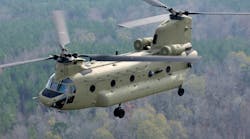By John Keller
WASHINGTON - Pentagon leaders plan to spend nearly $37.9 billion next year on military research, development, test and evaluation - a decline of $418.7 million from this year's research spending.
U.S. Department of Defense (DOD) research spending shows a general decline over the past several years as military
systems designers increase their reliance of commercial off-the-shelf (COTS) equipment, and by extension on industry-sponsored research.
Defense experts do not have an exact figure on how much of the military's research budget pertains to electronics and electronic equipment. Still, the Government electronics & Information Technology Association in Arlington, Va. - part of the Electronic Industries Alliance - predicted last October that at least $17.8 billion of the Pentagon's 2001 research budget will go toward electronics.
The Pentagon's budget request for research went to Congress in February, where lawmakers will consider it in hearings this spring and address the request formally in defense authorizations and appropriations bills next fall.
The U.S. Air Force, as usual, would receive the largest amount of the research budget. the Air Force research request for next year is nearly $13.7 billion, followed by defense agencies with $10.3 billion, the U.S. Navy with nearly $8.5 billion, the U.S. Army with $5.3 billion, and defense operational test and evaluation authorities with $201.6 million.
Highlights of the proposed Air Force research budget next year include:
- $1.4 billion for F-22 jet fighter engineering and manufacturing development (EMD);
- $569.2 million for the Space Based Infrared System-High program EMD;
- $299.5 million for Joint Strike Fighter EMD;
- $250.2 million for space and control segments of the NAVSTAR Global Positioning System;
- $246.4 million for space-based advanced EHF military satellite communications;
- $241 million for the Space Based Infrared System-Low program EMD;
- $168.1 million for B-1B bomber improvements;
- $148.6 million for the Airborne Laser Program;
- $134 million for space-based wideband military satellite communications systems; and
- $120.3 million for Joint Air-to-Surface Standoff Missile development, better known as JASSM.
Highlights of proposed research spending among the various independent Defense Department agencies next year include:
- $1.7 billion to the Ballistic Missile Defense Organization (BMDO) for national missile defense demonstration and validation;
- $382.7 million to BMDO for the Navy theater-wide missile defense system;
- $376.6 million to the Defense Advanced Research Projects Agency (DARPA) for computing systems and communications technology;
- $298.8 million to the National Security Agency for the Information Systems Security program;
- $274.2 million to BMDO for Navy area theater-wide missile defense EMD;
- $249.8 million to DARPA for materials and electronics technology;
- $191.8 million to DARPA for advanced electronics technologies;
- $182.2 million to DARPA for sensor and guidance technology;
- $164 million to the Office of the Secretary of Defense for the High Performance Computing Modernization program; and
- $162.1 million to DARPA for biological warfare defense technology.
Highlights of the proposed Navy research budget next year include:
- $305.3 million for advanced surface ship (SC-21) total ship system engineering;
- $296 million for Joint Strike Fighter EMD;
- $207.1 million for new fast-attack submarine designs;
- $149 million for aircraft carrier systems development;
- $143 million for land attack technology;
- $131.6 million for Joint Strike Fighter demonstration and validation;
- $119.3 million for Cooperative Engagement System development;
- $113.3 million for advanced submarine systems development;
- $113.1 million for tactical unmanned aerial vehicles technology; and
- $97.9 million for surface and shallow water mine countermeasures technology.
Highlights of the proposed Army research budget next year include:
- $614 million for RAH-66 Comanche scout-attack helicopter development;
- $355.3 million for advanced artillery systems demonstration and validation;
- $148.1 million for combat vehicle and automotive advanced technology applied research;
- $118.1 million for the Advanced Tank Armament System, better known as ATAS;
- $99.4 million for combat vehicle improvement programs operational systems development;
- $96.1 million for the Brilliant Anti-Armor Submunition, better known as BAT;
- $69.6 million for landmine warfare and barrier engineering development;
- $63.6 million for the Force-21 Battle Command, Brigade and Below program, better known as FBCB2);
- $62.2 million for the Joint Tactical Radio;


